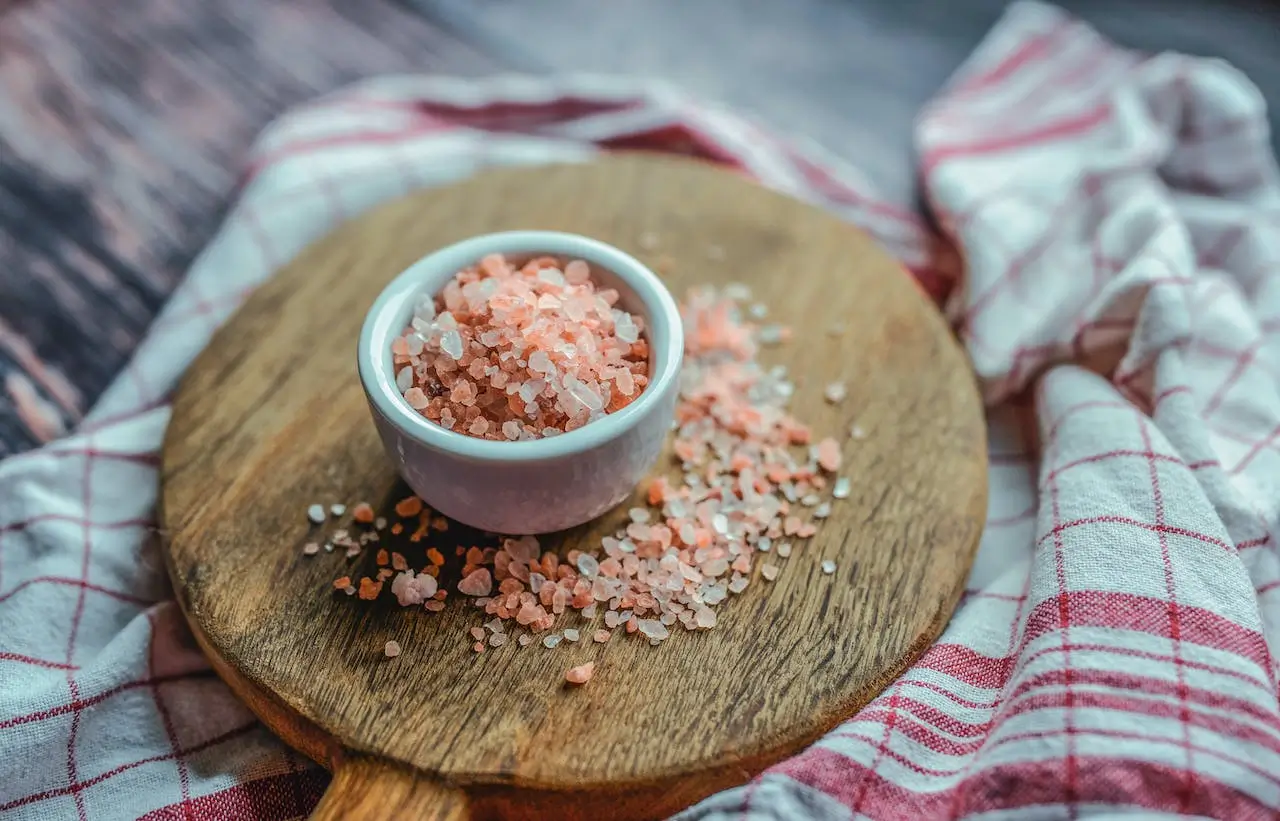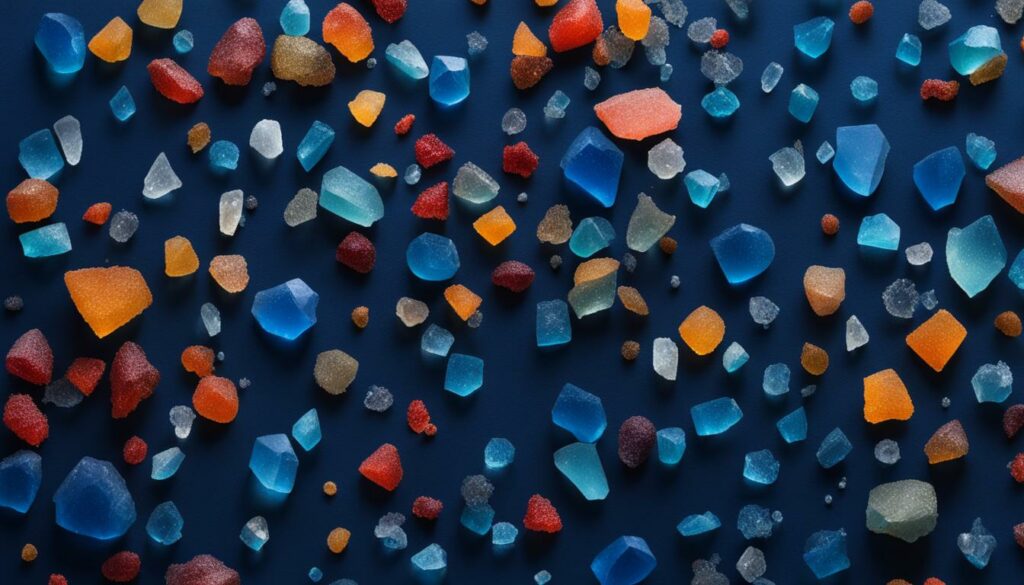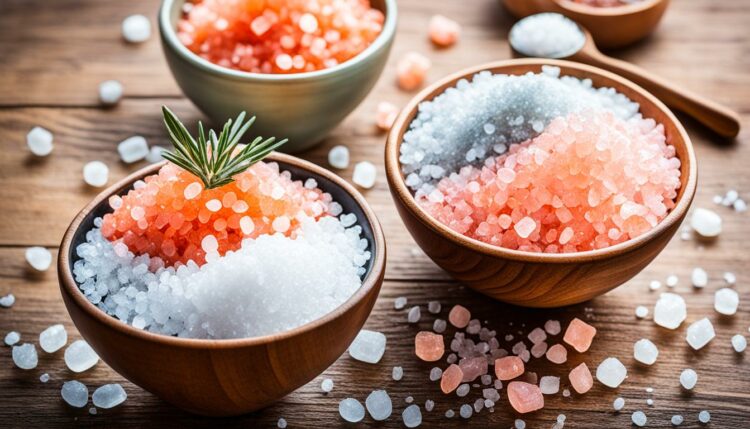Did you know that consuming too much salt can lead to serious health conditions like high blood pressure, heart disease, and stroke? As more people become health-conscious, the debate between sea salt and Himalayan salt as healthier alternatives to table salt has gained momentum.
While many believe that Himalayan sea salt is the superior choice, Mayo Clinic cardiologist Dr. Regis Fernandes argues that it is essentially the same as regular table salt since they both contain sodium chloride. So, is there really a significant difference between the two?
Key Takeaways:
- Consuming too much salt can lead to health conditions like high blood pressure, heart disease, and stroke.
- Himalayan sea salt and table salt both contain sodium chloride.
- The debate between sea salt and Himalayan salt centers around their mineral composition and potential health benefits.
- Both salts should be consumed in moderation as part of a balanced diet.
- Consult with a medical professional for personalized dietary advice.
The Differences in Mineral Composition
When comparing sea salt and Himalayan salt, one of the key differences lies in their mineral compositions. While both types of salt contain sodium chloride, there are notable variations in the additional minerals they offer.
Himalayan salt, also known as pink salt, boasts an impressive 84 beneficial minerals. These minerals include zinc and iron, which are not found in sea salt. These additional minerals contribute to the distinctive pink hue of Himalayan salt and offer potential health benefits.
Celtic Sea Salt, a type of grey sea salt, is renowned for its high moisture content and diverse mineral profile. It contains 72 minerals, including potassium, calcium, and magnesium, making it an excellent choice for those seeking a wide range of essential nutrients.
To visually illustrate the differences in mineral content between sea salt, Himalayan salt, and Celtic Sea Salt, refer to the table below:
| Sea Salt | Himalayan Salt (Pink Salt) | Celtic Sea Salt (Grey Salt) | |
|---|---|---|---|
| Sodium Chloride | ✓ | ✓ | ✓ |
| Zinc | ✓ | ||
| Iron | ✓ | ||
| Potassium | ✓ | ✓ | |
| Calcium | ✓ | ✓ | |
| Magnesium | ✓ |
As the table demonstrates, Himalayan salt stands out with its zinc and iron content, while Celtic Sea Salt offers a more diverse mineral profile, including potassium, calcium, and magnesium.
It’s important to note that both sea salt and Himalayan salt are considered healthier alternatives to table salt due to their higher mineral content. However, the actual health benefits of consuming these minerals are still being studied and debated among experts.

While mineral composition is a significant factor to consider, the choice between sea salt and Himalayan salt ultimately depends on personal preference and taste. Some individuals may prefer the milder flavor of Celtic Sea Salt, while others appreciate the robust taste of Himalayan salt.
Next, we’ll explore the culinary uses and flavors of these two salts, shedding more light on their unique characteristics.
Culinary Uses and Flavors
When it comes to culinary uses, both sea salt and Himalayan salt offer unique flavors and textures that can elevate your dishes to new heights.
Sea Salt:
Sea salt, with its mellow and briny flavor, is perfect for enhancing the taste of various foods. Its slightly moist texture makes it an ideal finishing salt, adding a delightful touch to salads, fish, and desserts.
Himalayan Salt:
Himalayan salt, on the other hand, boasts a robust flavor profile that adds a unique piquancy to your dishes. It is commonly used in grilling and curing, thanks to its ability to withstand higher temperatures while maintaining its distinct taste.
Both sea salt and Himalayan salt can be used in cooking and baking to season your dishes and provide an extra layer of flavor. They also add delightful texture, making them great options for adding a crunchy element to finished recipes.
Try Salt Blocks for Innovative Culinary Presentations
Himalayan Salt Blocks:
One innovative way to use Himalayan salt in your cooking is by using salt blocks. These blocks can be heated or chilled, allowing you to cook or serve food directly on them. Not only does it provide a unique and eye-catching presentation, but it also imparts a subtle saltiness and mineral-rich flavor to your dishes.
Whether you’re using sea salt or Himalayan salt, experimenting with different cooking techniques and recipes will allow you to unlock their full potential and enhance the flavor of your culinary creations.
Health Benefits and Claims
Celtic Sea Salt and Himalayan salt are renowned for their potential health benefits and unique mineral compositions. Let’s explore the benefits associated with these salts:
Celtic Sea Salt:
Celtic Sea Salt is believed to offer numerous health advantages due to its high moisture content and diverse mineral profile. It contains over 80 trace elements, including essential minerals like potassium, calcium, and magnesium. The presence of these minerals is vital for maintaining optimum health and bodily functions.
“Celtic Sea Salt’s unique mineral composition contributes to its potential health benefits, making it an excellent choice for enhancing overall well-being.”
Some claims even suggest that adding a pinch of Celtic Sea Salt to water can improve hydration. This is due to its electrolyte-rich composition, with minerals like potassium, calcium, and magnesium playing a crucial role in maintaining proper fluid balance in the body.
Himalayan Salt:
Himalayan salt is renowned for its rich mineral content, which includes iron, potassium, and calcium. These minerals are essential for various bodily functions, such as supporting respiratory function and promoting healthy sleep patterns.
“The mineral-rich composition of Himalayan salt may contribute to its potential health benefits, making it a favorable choice for overall well-being.”
It’s important to note that while Celtic Sea Salt and Himalayan salt offer potential health benefits, they should be consumed in moderation. Both salts are high in sodium, and excessive sodium intake can have negative effects on health.

Conclusion
In the ongoing discussion of sea salt vs Himalayan salt, both types of salt offer unique qualities and potential health benefits.
Celtic Sea Salt provides a diverse mineral profile and a mellow flavor, while Himalayan salt is renowned for its purity and rich iron content. Ultimately, choosing between the two may depend on personal preference and desired flavor.
It is important to note that while sea salt and Himalayan salt may offer additional minerals compared to table salt, they still contain sodium chloride and should be consumed in moderation. Excessive sodium intake can have negative effects on blood pressure and cardiovascular health.
To enjoy the potential health benefits of sea salt or Himalayan salt without overdoing the sodium intake, it is advisable to incorporate both salts into a balanced diet alongside other nutrient-rich foods.
By using these salts as part of a well-rounded approach to nutrition, individuals can enhance their culinary experiences while staying mindful of their sodium consumption.
FAQ
How does sea salt differ from Himalayan salt?
Sea salt and Himalayan salt have different mineral compositions. Himalayan salt contains 84 beneficial minerals, while sea salt has 72. Both salts contain sodium chloride, but Himalayan salt also offers minerals like zinc and iron.
What are the culinary uses of sea salt and Himalayan salt?
Sea salt, such as Celtic Sea Salt, is mellow and briny, making it ideal as a finishing salt for enhancing the flavors of salads, fish, and desserts. Himalayan salt, with its robust flavor, adds a unique piquancy to dishes and is commonly used in grilling and curing.
What are the health benefits of sea salt and Himalayan salt?
Sea salt, like Celtic Sea Salt, contains over 80 trace elements, including potassium, calcium, and magnesium, which are essential for optimum health. Himalayan salt is known for its rich mineral content, including iron, potassium, and calcium, and has been associated with promoting healthy sleep patterns and supporting respiratory function.
Is sea salt or Himalayan salt better for you?
Sea salt and Himalayan salt are considered healthier options compared to table salt due to their higher mineral content. However, it’s important to consume both salts in moderation as they are high in sodium.
Are there microplastics in sea salt?
Studies have shown that sea salt may contain microplastics, which are tiny pieces of plastic pollution. Further research is needed to understand the potential health risks associated with consuming microplastics.




